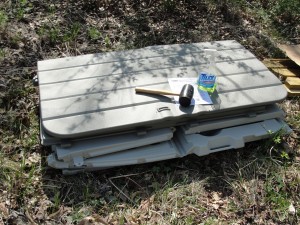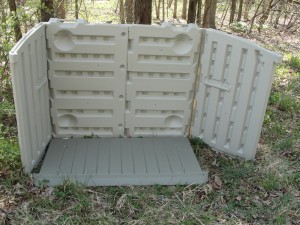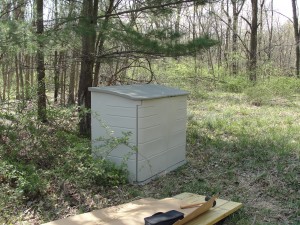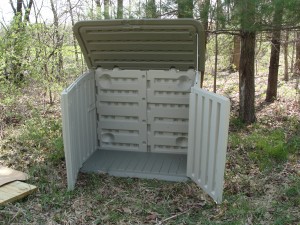If I were to actually engage in any kind of brush clearing, I would need a place to keep my tools secure and out of the elements.
The tool box needed to be large enough to hold my String Trimmer, fuel, herbicide, sprayer, gloves and other protective gear. It also needed to be durable and weather tolerant since it would be sitting outside in the forest year round.
After a lengthy search online and weighing the alternatives, I settled on a Rubbermaid 32 Cubic Foot Horizontal Storage Shed. I’d had good experience with Rubbermaid products in the past, it seemed durable enough, and assembly was probably within my skill level.

Assembly required two tools, a rubber mallet (presumably for giving a good whack), and dilute dish detergent (to provide lubricant, in the event a good whack with the rubber mallet proved insufficient). I placed my order with Amazon.
The box arrived two days later, and weighed over 100 pounds. Two delivery men and a dolly wheeled it into my garage and set it on the concrete floor. There was no way I could lift the box into the car for transport to the Timber Pasture. So I left it there for a while, while I thought about this.
I shouldn’t have been surprised by the weight of the shed, since it was clearly posted on Amazon, but I just hadn’t considered the weight issue.

In the end, I decided, I could simply unpack the box and load each individual piece of the shed into the back of the car. This worked well, and at the next opportunity, I was at the timber pasture and assembling my storage box.
It was a clear, cool day in mid-April. No mosquitos, and a nice intermittent breeze. There was an interesting amount of chatter from the birds, not something I’m used to in my suburban house.

In choosing a place to build the storage box, I admit I was influenced by its’ weight. I decided to place it close to the front gate, where I wouldn’t have to carry it very far. I realized that positioning made it more vulnerable to someone deciding to break in and see what might be in the box, but I wasn’t about to lug the 100+ pound box deep into the woods.
The directions were clear, and I had no difficulty in assembly. I never actually needed the soapy water to act as lubricant since the pieces slid together pretty easily. I did use the rubber mallet twice, to get each side panel to seat securely in the base panel, but if I hadn’t had the rubber mallet, I think I could have muscled it into place, particularly if I had the soapy water to lubricate the fitting.

The tool box had a number of nice features that I hadn’t appreciated when selecting it. The top lifts up to about a 60 degree angle and locks in place with a steel strut. The mechanism is simple, intuitive, and works well. Having this top access was useful in quickly finding and removing tools.
Closed, the top includes a ring for a padlock, which I employed. Look, this isn’t the most secure tool box in the world, and it certainly wouldn’t withstand a determined effort to break in. But it does provide protection against curious animals, insects, weather, and the casual passerby, but probably not so much against the determined criminal.
The swing-open side doors worked well. When closed, they were secured by the top of the box, which in turn could be padlocked.
When I visited the woods a month later, the box was standing just as I had left it. No insects had infested the interior, but there were a few bird droppings on the top. That didn’t bother me. It was no secret there were birds in the woods, and I was glad to see the tool box working the way I had hoped it would work.
